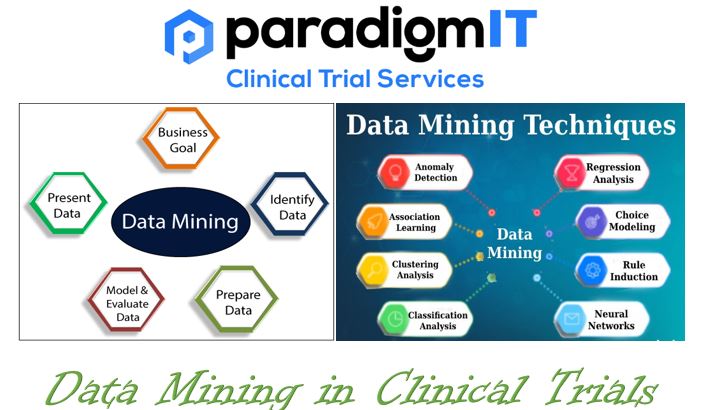Data Mining in Clinical Trials
Visit our website – www.paradigmit.com or write to us at ask@paradigmit.com
In 2006, Clive Humby, a renowned British mathematician and entrepreneur in data science, coined the phrase, “Data is the new oil”. Two decades later, clinical researchers and data scientists are relating to this statement in a much more powerful way. In modern-day healthcare, there is no shortfall of data. Public health Databases hold annals of valuable and multi-dimensional data. But, due to its heterogeneity and unrefined nature, it is often deemed unusable. Data mining as a technology can resolve this problem of too much data and too little utilization. Clinical Research with data mining can help build unique disease prediction models and treatment regimens.
The synergistic power of electronic health records (EHR), artificial intelligence (AI), machine learning (ML) and advanced statistical methods enables the possibility of data mining in healthcare. While descriptive data mining captures the current disease/treatment landscape, predictive data mining focuses on forecasting new patterns and models. In any form, clinical data mining brings previously unknown clinical knowledge and information to the limelight and helps make meaningful inferences for clinical application.
The following are the four crucial steps of clinical data mining,
- 1 . Identification and assessment of clinical data sets:
- In this step, researchers identify and assess the available clinical data sets relevant to the research question or objective of the study.
- Researchers understand the data sources and evaluate the quality and completeness of the data sets, ensuring that they contain the necessary variables and information required for analysis.
- They also consider any ethical and privacy concerns related to data access and usage.
- 2. Pre-formatting and normalization of the acquired data
Once the relevant data sets are obtained, the next step is to pre-format and normalize the acquired data.
- This process involves preparing the data for analysis by ensuring consistency, addressing missing values, handling outliers, and standardizing the data format. Data cleaning techniques are applied to remove any inconsistencies or errors.
- Normalization techniques may be used to transform variables into a standard scale or format to ensure comparability and eliminate biases.
- This step is crucial to ensure the data is ready for further analysis and to minimize any potential biases or confounding factors.
- 3. Application of data mining algorithms
After the data has been pre-processed and normalized, data mining algorithms are applied to extract patterns, relationships, and insights from the data.
- Various data mining techniques can be used, including classification, regression, clustering, association rule mining, and text mining, depending on the research question and the nature of the data.
- These algorithms analyze the data to identify trends, predict outcomes, discover hidden patterns, or segment the data into meaningful subgroups.
- The choice of algorithms depends on the specific objectives of the study and the characteristics of the data.
- 4. Interpretation of results and gaining clinical insights
The last step would be interpreting the results and deriving the clinical insights.
- Researchers analyze the patterns and relationships discovered through data mining techniques to gain a deeper understanding of the data and its implications.
- This involves interpreting the statistical significance of the findings, evaluating the clinical relevance of the patterns identified, and assessing the implications for patient care or future research.
- Researchers may also validate their findings through additional analyses or external validation using independent data sets.
Based on whether the data sets identified contain dependent variables, supervised and/or unsupervised learning models are applied. High-quality data, if available, can maximize the potential of data mining technology and since most of these algorithms can adopt self-learning (like generative AI), the accuracy and speed exponentially increase over time. As the sensitivity, specificity, and predictive value of clinical data mining increases, there will be better acceptance from the healthcare community for widespread application.
Though there is a lot of potential for clinical data mining to be the backbone of future healthcare, there are still several hurdles to overcome for this to become a reality. Data inconsistency, Data protection policies (like GDPR, HIPAA, etc…), Data storage (like Public Domain or Cloud) and Data inadequacies are some of the most common challenges that clinical researchers will face before realizing the full-fledged potential of clinical data mining. However, with the rapid introduction of novel methods and technologies, clinical data mining tools are here to stay as a beneficiary instrument to improve patient outcomes at individual and population levels.
For more information –
Visit our website – www.paradigmit.com
Or you can write us at ask@paradigmit.com
Follow us for more – https://www.linkedin.com/company/paradigmittechnologyservices/?viewAsMember=true


